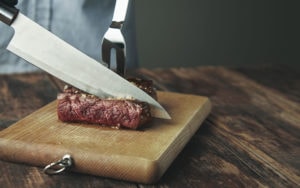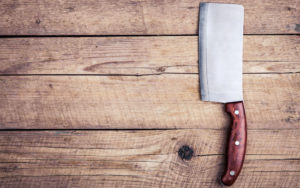 Most people who just buy knives aren’t really familiar with ATS 34 steel. It’s not really found in many knives, and part of the reason for that is because it’s a rather high-end steel.
Most people who just buy knives aren’t really familiar with ATS 34 steel. It’s not really found in many knives, and part of the reason for that is because it’s a rather high-end steel.
If you’ve stumbled upon a knife you want to buy that comes with an ATS 34 steel blade, then you need to find out exactly what it offers. With this ATS 34 review, you’ll get answers to your questions and discover if it’s a good idea to have ATS 34 steel for knife products.
What is ATS 34 Steel?
This is actually a type of carbon/stainless steel that originated in Japan. More specifically, it was developed by Hitachi Steel. It’s a high-quality steel that has become quite popular with an increasing number of custom knife makers. That’s especially true when the renowned custom knife maker Bob Loveless started using it.
It’s basically a very similar steel to 154CM steel, which Bob Loveless previously used to make his custom knives. But Crucible stopped their 154CM production, so Bob Loveless basically asked Hitachi steel to create its own version with the same characteristics. That led to the creation of ATS 34 steel.
Common Uses of ATS 34 Steel
- Custom knives. This is perhaps its most common use.
- EDC knives. Its characteristics let this work very well for everyday tasks like cutting cords and opening packages.
- Camping and hunting knives. You may find some of these ATS 34 knives, though they’re not very common. They’re mainly made by premium brands.
- Kitchen knives. The ATS 34 steel also works for kitchen duty.
ATS 34 Steel Chemical Composition
To better understand why knifemakers (and knife buyers) like ATS 34 steel, check out the recipe for its creation:
- Carbon, 1.05%
- Chromium, 14%
- Molybdenum, 4%
- Manganese, 0.4%
- Silicon, 0.35%
- Phosphorus, 0.03%
- Sulfur, 0.02%
Carbon, 1.05%: This qualifies ATS 34 as a very high-carbon steel. Many (if not most) carbon steels contain less than 1% carbon. In fact, the most common grade for carbon steel is low-carbon steel, which contains less than 0.30% carbon.
The carbon is the most crucial component, as it determines the hardness of the steel. In this case, ATS 34 is hard enough to offer good wear resistance and terrific edge retention.
Chromium, 14%: This is enough chromium for corrosion resistance that ATS 34 is part of the stainless steel category as well. To be considered stainless steel, a steel type has to contain at least 10% chromium (though some people insist that it has to be 12%).
Keep in mind that 14% chromium is not nearly enough for long-term use in high-moisture conditions. A lot of other alloys are more resistant to corrosion.
In addition, it helps with boosting the yield strength and hardenability of the steel.
Molybdenum, 4%: Remember how ATS 34 was patterned after the 154CM formula? Well, 154CM came about when its maker Crucible added some molybdenum to 440C stainless steel.
There’s actually a lot of molybdenum here, given that most steel alloys have less than 1% molybdenum. It helps with hardenability, elevated temperature strength, corrosion resistance, and creep strength.
Manganese, 0.4%: Like carbon, it helps to make the steel harder. More specifically, it increases hardenability and tensile strength. But the amount is limited, because too much manganese reduces the ductility of the steel.
Silicon, 0.35%: It also boosts hardness and strength, though not as much as manganese.
Phosphorus, 0.03%: It’s not good to have too much phosphorus, since it can make the steel brittle instead of tough. But this is just enough to increase the machinability and tensile strength.
Sulfur, 0.02%: Like phosphorus, sulfur in steel isn’t good in large amounts. But a little sulfur helps with machinability.
ATS 34 Steel hardness
In most cases, the hardness of ATS 34 steel is rated at 61 HRC. That’s actually quite hard, and great for edge retention and wear resistance.
Properties of ATS 34 Steel
ATS steel is actually performs well in many categories. If you’re looking for a good all-around steel, then ATS 34 can do the job. It balances all crucial factors nicely.
Terrific Edge Retention
This is perhaps the most notable feature for ATS 34 steel. It takes a while to dull the blade, which is great for tasks like opening packages all day long. You won’t have to keep sharpening the blade in the middle of the day.
Great Wear Resistance
This is also related to edge retention. But you can also say that ATS 34 can hold up longer when you take care of it. It’s great for rough for, like for camping and hunting.
Decent Corrosion Resistance
That’s mainly due to the chromium content, which qualifies ATS 34 as stainless steel. This is why knives using ATS 34 can work for camping, hunting, and even kitchen duty.
At the same time, its corrosion resistance isn’t really terrific. In fact, it may be more prone to corrosion than 440C steel, which is considered a lower-grade steel.
Good Toughness
Despite the relative hardness of ATS 34 steel, its toughness isn’t all that bad. That’s to say, it can stand for most cutting tasks and it’s not really likely to chip off. Despite the hardness, it’s not really brittle.
Not Difficult to Sharpen
While it can be a pain to sharpen out in the field, it’s not all that hard to sharpen at home with the right equipment. It’s not really super-hard, though somewhat harder to sharpen than most common knives.
ATS 34 Equivalent Steels or Alternative
You can get a better picture of the ATS 34 steel performance when you directly compare it with other similar steel types.
ATS-34 steel vs s30v Steel
The s30v steel is another good all-around steel, and it was also made by Crucible. It’s a favorite steel used for high-end kitchen cutlery and pocket knives. It’s considered a premium type of steel, slightly above the merely “high end” ATS 34 steel.
The s30v steel is a bit better when it comes to retaining its sharp edge and resisting corrosion. On the other hand, ATS 34 is somewhat easier to sharpen.
ATS-34 vs 440c Steel
The 440c stainless steel occupies a lower tier than the ATS 34 when it comes to overall quality. The 440c was actually considered a high-end steel back in the day, but it’s now been overshadowed by newer alloys.
This comparison is a case in point. Both these steels are easy to sharpen, but the ATS 34 comes out ahead (by a significant margin) in both edge retention and corrosion resistance.
However, if you find a knife using 440c steel, it’s likely more affordable than its ATS 34 counterpart.
ATS-34 vs D2 Steel
Industry experts consider both ATS 34 and D2 steel as high-end steels. D2 is famed for its notable hardness, which means it retains its sharp edge for a good long while (and longer than ATS 34 steel).
On the other hand, this super-hard D2 steel is consequently much harder to sharpen. You actually have to be an expert in sharpening to do a good job at it.
Also, D2 doesn’t have as much chromium, and it’s even considered “semi-stainless”.
Is ATS 34 Steel Good for Knives?
 It’s good enough for Bob Loveless, so what do you think? In other words, yes, it’s good enough for knives.
It’s good enough for Bob Loveless, so what do you think? In other words, yes, it’s good enough for knives.
In fact, you’ll find it used in custom knives and high-end field and kitchen knives. It is high-quality steel, and you’re likely to find it in premium knives. It can work all day cutting, without any trouble at all. Once you’re done, sharpening it isn’t as difficult as you might think.
Pros & Cons of ATS 34 steel
- This retains its sharp edge very well, so it can cut cords and packages all day long.
- Despite the hardness of the steel, its toughness isn’t all that bad. That’s to say, it’s not as liable to chip like other steels with similar hardness levels.
- Also, it’s not that hard to sharpen, either.
- It has enough chromium that it qualifies as stainless steel.
- Lots of other stainless-steel knives (cheaper than knives using ATS 34 steel) are more resistant to corrosion.
- You may want to invest in good sharpening equipment to make sure you get it right.
- It’s not exactly cheap.
Conclusion
The presence of ATS 34 steel most likely signals that the knife is of premium quality. It will do its job for a long time without needing to resharpen too often. When you do need to sharpen the blade again, it’s really no trouble.
This is a high-end type of steel, which does mean you may have to pay more for it. But for its quality, you sure get a lot of bang for your buck.